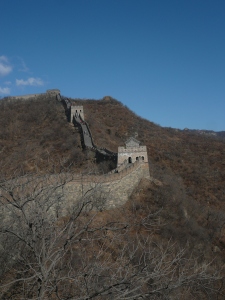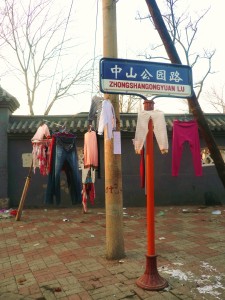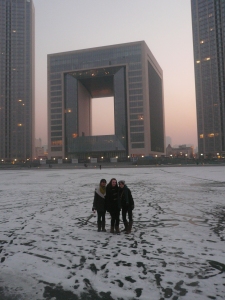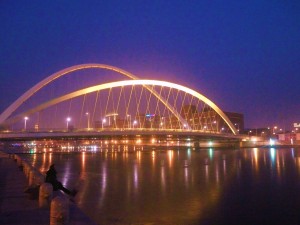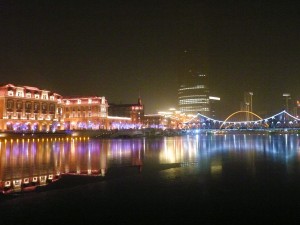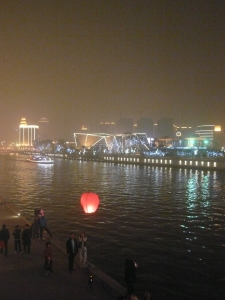Backpacks, inter-railing, hostel horrors – intrepid travelling is one of those things I’ve thought about, but never actually done. Until now, that is.
I remember seeing students heaving rucksacks bigger than my 15-year-old self onto European trains and thinking what an adventure it must be, taking off with nothing but one bag and a few friends. When I have taken off with friends – Tuscany, Budapest, Miami – it’s been flights and hotel rooms, not crammed trains and dorms. Well, that all changed in the middle of January. On the 15th of the first month of the year, I set off with four friends and a backpack as big I was (which I admit isn’t saying much) on a trip that took me through three weeks, eight destinations, four trains, two buses, a few ferries and 1000-plus photos.
 Spring Festival – also known as the Chinese or Lunar New Year – is the big winter holiday, comparable to the Christmas celebrations at home. With six weeks off school, it was the break from classroom fatigue we had all been waiting for. This is the time when people head home to be with their families; roughly 1 billion people are on the move within the same few weeks, making travel tempestuous. While we did have to wait in ticket lines enduring sub-zero temperatures, the train journeys themselves were not the horrors we expected.
Spring Festival – also known as the Chinese or Lunar New Year – is the big winter holiday, comparable to the Christmas celebrations at home. With six weeks off school, it was the break from classroom fatigue we had all been waiting for. This is the time when people head home to be with their families; roughly 1 billion people are on the move within the same few weeks, making travel tempestuous. While we did have to wait in ticket lines enduring sub-zero temperatures, the train journeys themselves were not the horrors we expected.
Our first high-speed train took us to Nanjing, one-time capital of the country. The Ming Dynasty City walls were impressive, as was the resting place of China’s ‘ founding father’, Sun Yat Sen, but none of us were sad when it was time to speed on to Suzhou. The guidebooks call Suzhou the Venice of the East – it’s not, but it’s not bad either. Shrouded in snow, the famous gardens were a sight to see. Our old courtyard hostel also looked sweet under the snow, but the lack of heating, flimsy wooden doors and showers that were almost outside (literally) dampened the experience.
No amount of snow could dampen my enthusiasm for our next stop, a place – as regular readers will know – that has already topped my travel list : Shanghai. A Sunday morning stroll along the Bund, copious amounts of xialongbao dumplings, sky-high cocktails – what’s not to love? A visit to the Urban Planning Exhibition might sound dull, but gives a real insight into the city’s changes; Shanghai just keeps getting bigger and better. Add in some traditional gardens, the not-so-old “Old Quarter” and the mind-boggling journey that is a visit to the China Expo Pavilion, and you have Shanghai take two.
As much as I loathed leaving Shanghai, nearby Hangzhou was beyond all expectations. As the Chinese saying goes “Above is heaven, below is Hangzhou”. After a wild goose chase, we managed to hire bikes and pedal round the beautiful West Lake, before drinking in the sunset over the mountains. It was here we caught another glimpse of that ubiquitous contrast between old and new: Gucci preens proudly a few blocks from teeming market streets and bargain stores.
Further south we stopped at coastal resort Xiamen and the old colonial island of GuLang Yu. Monks in the chocolate aisle at the supermarket, palm trees lining the streets – Xiamen was like a Med resort with a twist. GuLang Yu, with its cobbled streets, red tiled rooftops and colourful fishing boats, was the setting for quite a few of those thousand-plus pictures.
A few hundred miles later, we were ready to welcome in the Year of the Rabbit. From the neon overload of Mong Kok and Nathan Road in Kowloon, to the sleek financial-come-retail real-estate across Victoria Harbour at Central, Hong Kong has everything you could ask for. Markets, high-end boutiques, smelly street food, classy bars, teeming side streets, deserted beaches, city-scapes, tropical retreats – this confusingly British-style Chinese city was the perfect place to celebrate New Year.
For Spring Festival, most Chinese stay at home with their families, where they welcome in the New Year by staying up watching TV, letting off fireworks and eating dinner together. To prepare for the New Year we went to the Flower Market, where a buzz similar to that of Christmas shopping hung in the air. Kumquats for prosperity, blossoms for happy relationships – people were buying in bulk to bring in luck. We welcomed the Year of the Rabbit with a visit to the Tian Tan Buddha and a beach or two before returning to Kowloon for the New Year parade and a night of dancing in Lan Kwai Fong, Hong Kong’s party precinct.
watching TV, letting off fireworks and eating dinner together. To prepare for the New Year we went to the Flower Market, where a buzz similar to that of Christmas shopping hung in the air. Kumquats for prosperity, blossoms for happy relationships – people were buying in bulk to bring in luck. We welcomed the Year of the Rabbit with a visit to the Tian Tan Buddha and a beach or two before returning to Kowloon for the New Year parade and a night of dancing in Lan Kwai Fong, Hong Kong’s party precinct.
After three weeks of intrepid travelling down China’s east coast, what did we learn? Be wary of the guide book – the scenic area will probably not be scenic. We speak Mandarin with a Beijing accent. Some people really will go out of their way to help you (and others will not). In such a huge country, even small regional differences are palpable – from accents to food, we were out of our recently acquired comfort zone.
We didn’t return to TJ that soon, however. As my backpack buddies headed for Yunnan, I took off in the opposite direction, across the Pacific. As bagels, beer pong and Broadway shows don’t exactly fall under the remit of a China blog, those stories will have to be saved for another time. Suffice to say, two weeks Stateside were the perfect ending to my winter break.
Happy New Year of the Rabbit! Here’s to another few months of tales in Tianjin…
Tags: Chinese New Year, Photography, Spring Festival, Travel, Year of the Rabbit

